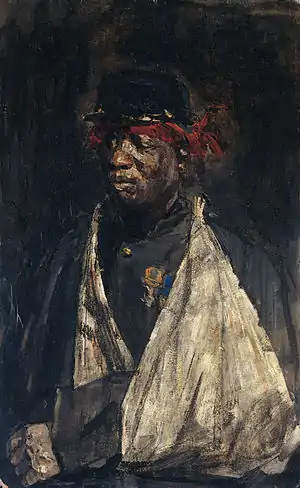Portrait of a Wounded KNIL Soldier
Portrait of a Wounded KNIL Soldier is a signed and dated 1882 Amsterdam impressionist portrait painting by Isaac Israels. It has been in the Rijksmuseum since 2000.
| Portrait of a Wounded KNIL Soldier | |
|---|---|
 | |
| Year | 1882 |
| Medium | oil paint |
| Dimensions | 37 cm (15 in) × 23 cm (9.1 in) |
| Location | Rijksmuseum, Netherlands |
| Accession No. | SK-A-4954 |
The sitter was identified in 2000 by Eveline Sint Nicolaas as Kees Pop, a KNIL soldier from Africa. Such men were recruited during the period 1831-1872 as Zwarte Hollanders in Elmina and given names that were pronounceable for their military superiors.[1][2] ‘Pop’ was possibly from Elmina, but could have been born as far north as Burkina Faso or as far East as Nigeria. He served 12 years in the Aceh War. Under his mitella the medals for the Expedition Cross and the Aceh Medal can be seen. His colleague Jan Kooi was portrayed in the same year by J.C. Leich in a much more heroic, realistic military fashion, whereas Israels was much more interested in the drama of the sitter's personal story. This portrait shows the effects of a long military career in a foreign country surrounded by African comrades who themselves spoke different languages, answering to a name from a foreign language. Israëls had a fascination for Dutch East Indies, possibly fostered by his friendship with the Dutch painter Johannes Evert Hendrik Akkeringa, who was of mixed Indonesian heritage. Though the first World War caused him to delay, Israëls did manage to visit Dutch East Indies himself, where he made many paintings during the course of a two-year stay in 1921, armed with introductory letters from Akkeringa.
Legacy
This portrait, along with the portrait of Jan Kooi, were featured in the 2008 art exhibition in the Amsterdam Nieuwe Kerk called "Black is Beautiful", and sparked a national conversation about the "Indo-African" community that nearly a century later arrived in the Netherlands from Indonesia after WWII and some of whose members were possible descendants of these men. The artist Pieter Hugo made a portrait photograph that nods both to this "impressionist" painting and to the Jan Kooi "realistic" painting.[3]
References
- SK-A-4954 painting record in the Rijksmuseum
- 2018 blogpost by Esther Schreuder about this painting and the work done by Sint Nicolaas
- Pieter Hugo inspired by Isaac Israëls, blog by Esther Schreuder, curator of the "Black is Beautiful" exhibition
- Black is beautiful: Rubens tot Dumas, exhibition & catalog in Nieuwe Kerk Amsterdam, 2008
- Een Afrikaan in dienst van het KNIL : een zoektocht naar de naam bij het gezicht article by Eveline Sint Nicolaas in the Rijksmuseum bulletin, 2000